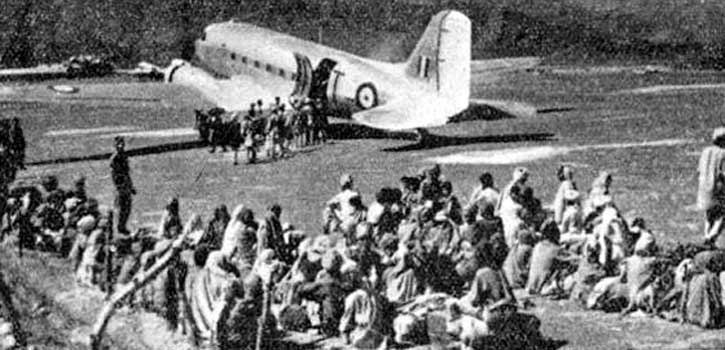Indo-Pakistan War of 1947

The first war between India and Pakistan began in October 1947 and ended in December 1948. The origins of the first war between India and Pakistan can be traced to the final status of Kashmir following the establishment of an independent India and Pakistan on August 15, 1947. British policy held that the various princely states would have to accede to either Pakistan or India based on geographic location and on demographics. While the final status of many of the states was easily concluded, Kashmir and two other states presented special problems.
Kashmir was strategically located between India and Pakistan and though it was led by a Hindu Maharaja, Muslims made up the majority of the population. Sikhs and Hindus made up the other major ethnicities though they were a minority compared to the Muslim population. Though required to choose between the India and Pakistan the Maharaja was unable to decide which state to join.
Both states applied a significant degree of pressure to sway Kashmir's government. Pakistan felt that as it was the established state for Muslims in South Asia that Kashmir should accede to it rather than India. Unfortunately, though Kashmir was majority Muslim, the majority of the population of Kashmir (including a majority within the Muslim population) did not support joining Pakistan and instead wished to join India or for independence from the two states.
Tensions between Pakistan and the government of Kashmir grew as the Maharaja's indecision frustrated Pakistan and pro-Pakistani factions within Kashmir. Hostilities began in early October 1947 when a tribal rebellion broke out in Poonch in southwest Kashmir. By October 20th the Pakistani Army entered the conflict in support of the tribal forces in a multi-pronged effort designed to capture Uri, Jhangar, Rajuara, and Naushera in the opening days of the campaign. Pakistan's timetable was to capture the capital of Kashmir, Srinagar, within a week.
On October 22, 1947, a Lashkar of tribal, some five thousands strong, led an incursion into the valley of Kashmir from Abbottabad. Tribal and Pakistani forces experienced significant successes in the opening days of the conflict as they were able to take Dommel on the first day and overpowered a Kashmiri government battalion at Muzaffarabad by October 23. On October 26, 1947, after four days, they were in the vicinity of Srinagar. The Dogra Army seemed to have been beaten. The Maharaja had already fled his capital, Srinagar, to seek the comparative safety of Jammu.
Tribal and Pakistani forces met fierce resistance at Uri, where Kashmiri government forces, despite the desertion of many of its Muslim troops, were able to delay the Pakistani forces for two days until it was destroyed. Retreating Kashmiri forces were able to destroy a key bridge thus delaying Pakistani forces for an additional day.
Pakistani efforts to the south in the Jammu region were less successful as Pakistani forces faced significant resistance and were prevented from gaining most of the towns and locations that Pakistan attempted to capture.
Following the fall of Uri Pakistani and tribal forces took Baramulla and began to march on Srinagar. The Pakistani-backed forces were able to damage an important power station, located in Mahura that supplied electricity to Srinagar. In the following days the invading forces were able to get within a few miles of the airfield near Srinagar.
Up to this point the Pakistani-backed forces had faced opposition only from the Kashmiri government forces. The Maharaja, facing overwhelming odds and near certain defeat, asked India for military support. India agreed to help provided that Kashmir acceded to India and that the Prime Minister of Kashmir agreed to the accession. Both the Maharaja and the Prime Minister agreed to these terms and on October 26 the Maharaja signed the Instrument of Accession.
At that moment when the Lashkar was preparing to enter the State Capital, Lord Mountbatten, the first Governor General of India and the Chairman of the provisional Defence Committee, reacted with exceeding speed on behalf of India, and air-lifted Indian troops for operations to halt the tribal incursion.
India's 161st Infantry Brigade was deployed and thwarted the advance of the tribal forces. In early November 1947, the 161st using armored cars, counterattacked, surprising the Pakistani forces and successfully broke through their defenses. The 161st was flown into the airfield at Srinagar and from there was able to repulse the Pakistani-backed forces. Initial successes allowed the Indians to secure the airfield and to return power to Srinagar. The momentum of the Indian counterattack forced the Pakistani forces into a full retreat allowing elements of the 161st to retake Baramulla and Uri.
Despite early successes, the Indian army suffered a setback in December 1947 because of logistical problems. Furthermore, many of the Indian soldiers were ill prepared for fighting in the mountainous region of Kashmir and Jammu; few neither were experienced at high altitude combat nor were they prepared for the cold. These setbacks were significant as the Pakistani-backed forces were able to capitalize on these problems and to push back Indian forces from the border area.
In the spring of 1948, the Indian side mounted another offensive to retake some of the ground that it had lost. Pakistani regulars were introduced into the conflict later in the year, targeting the city of Jammu. The fighting from the spring through December 1948 was widespread as Pakistani forces conducted operations in both the north and the south.
The intensity of the conflict and the inability to foresee a quick end to the conflict without involving considerable resources on the part of India to expel the Pakistani forces led Indian leaders to approach the United Nations who ultimately introduced Observers in June 1948. A UN brokered cease-fire went into effect on Jan. 1, 1949.
In all, 1,500 soldiers died on each side during the war and Pakistan was able to acquire roughly two-fifths of Kashmir which it established as Azad Kashmir, meaning free Kashmir.



